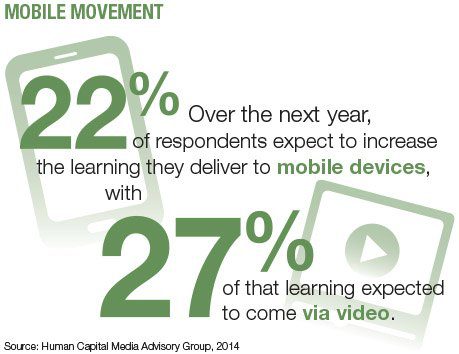Henry Ford’s assembly line was a fast and efficient way to produce cars. It’s a far less effective way to teach employees.
Instead of giving employees all the tools they’ll ever need upfront, informal learning programs provide knowledge as it becomes relevant, which can ultimately lead to better prepared and more productive employees.
There are similarities between the way the automaker achieved maximum productivity and the way modern-day companies structure their formal learning programs, said Bob Mosher, senior partner and chief learning evangelist at strategic consulting firm APPLY Synergies and who is also a Chief Learning Officer columnist.
“Formal learning operates on almost a Henry Ford assembly line model in that it crams people through classrooms,” he said. “We throw everything in a class because we have the learners for a day or two, and we have to fill that time. We throw a lot at them, things that might not be relevant yet, and then they’re gone.”
While he recognizes its value, Mosher said formal training is a model of convenience. He offered Russian physiologist Ivan Pavlov’s dog experiment to explain why companies would be wise to shift focus to driving and capturing informal learning within their organizations: The closer the stimulus is to theresponse, the higher the probability of inducing a behavior.
Despite this fact, formal classroom settings are still the way most employers educate their employees. According to a 2014 survey conducted by the Human Capital Media Advisory Group, the research arm for Chief Learning Officermagazine, classroom-based learning delivery infrastructuresremain the primary learning delivery method. Yet, 49 percent ofrespondents felt their organization’s learning delivery infrastructure and functions are prepared to meet business needs.
“We need to move learning into the workflow so is has meaning and relevance,” Mosher said. “The learner is in a whole different place emotionally. There is urgency. There is focus. All these wonderful things that we try to emulate in the classroom are present in the informal learning environment. The more learning that is done in the informal domain, the higher the probability of an effective outcome.”
However, capitalizing on informal learning requires an effective technology strategy, which most companies lack. According to the aforementioned survey, only 12 percent of respondent organizations currently deliver learning to mobile devices.
But the tide is turning. Over the next year, 22 percent of respondents expect to increase the learning they deliver to mobile devices, with 27 percent of that learning expected to come via video.
Simply moving material to a new platform is not enough. Companies that maximize informal learning’spotential devise ways to capture and distribute individual moments of learning across the organization so that all employees benefit. High-tech software that use video and drive in-the-moment employee collaboration are effective in some settings, but employers must always consider how technology fits into their employees’ workflow so that it remains a tool, not a distraction.
A Formal Approach to Informal Learning
However beneficial it might be, it’s not easy to create a formal program to capture an organic process. Mosher said he and his colleagues struggle with the term “informal learning” because it implies that learning is delivered haphazardly, which should not be the case.
Instead of focusing on new and flashy delivery methods, he said focus on how learners will consume information provided. The first step is to make sure learning is embedded in the employee’s everyday routine.
 “The tendency is to take the learner out of the informal domain, and make them walk over to a different place to learn,” Mosher said. “But if I have to leave my station, I’m just doing formal learning somewhere else.”
“The tendency is to take the learner out of the informal domain, and make them walk over to a different place to learn,” Mosher said. “But if I have to leave my station, I’m just doing formal learning somewhere else.”
Then learning leaders have to make sure the information offered is contextual. Mosher said learners can be selfish. If they are being presented with information not directly relevant to their task at that moment, they won’t care.
This is a pain point for many learning departments that have to create content for every position within a company. Karie Willyerd, SAP’s vice president of learning and social adoption, said this does not have to be the case. Willyerd is also the former CEO of Jambok, a social learning platform acquired by SuccessFactors in 2011. Her company created a peer-to-peer learning approach that used “crowd speak” to source content for clients’ informal learning programs.
“Employees will only share what there is demand for, so it makes the most sense to let them curate their own content to share peer to peer,” Willyerd said. “It is less expensive and ultimately more effective.”
Willyerd cited an example of a large retail chain that set up an internal video messaging platform that allowed store managers to converse in the moment. Store managers could determine the best way to display items to maximize sales while recording the conversation. It could then be posted to a message board accessible to the entire company, and employees could share needed information faster than a formal training response could be developed.
Mosher’s final step is to serve up learning that is “just enough.” This is a struggle for designers who are trained to deliver learning in condensed time periods. “This is probably the most broken rule because we just can’t shut up,” he said. “But in informal learning, I just want to make the burger. I don’t need to know how to make the fries or the history or the burger itself. I just want to make a Big Mac right now.”
In addition to Mosher’s three guiding principles, Willyerd said it’s important to cultivate informal learning before an employee’s first day on the job. “Give employees the opportunity to meet other new hires and start to learn informally from each other so they are comfortable sharing knowledge on the job.”
Don’t Be Fooled by the Flash
While employees appear to possess the ability to solve a lot of an organization’s learning problems, learning leaders are still struggling with exactly how to tap into the resource.
Beginning in 2009, Leslie Teichgraeber, vice president of PepsiCo University, oversaw rollout for a corporate university program designed to drive global learning across the company. However, she still struggles with how to best capture and share the learning experiences PepsiCo’s thousands of on-the-ground workers have each day.
For instance, constructing product displays is a significant pain point for the organization. How can informal learning help alleviate that pain? “Maybe post a video of a display that they put together in a store and how they did it, or some problems they might be having with a rack and how they might be able to reconstruct it,” Teichgraeber said. “Things like that would be really easy to do; we just haven’t figured out the right way to go about it yet.”
However, Mosher cautions learning leaders against relying on the latest technology to solve all of a company’s problems. “Video is a really powerful informal learning modality,” he said. “But my first question is: Can the drivers watch a video in their workflow? If they can’t, then stop. The informal learning solution won’t succeed.”
While it lacks the bells and whistles of other high-tech informal learning software, laminated 3-by-5 note cards with problem-shooting solutions are one alternative. “We often find in informal learning that we like things that look cool,” Mosher said. “But we have to see if they stack up to the design and consumability principles of what informal learning needs to be. If they don’t, don’t build them because employees aren’t going to take them.”
In fast-paced industries such as food service and retail, however, technology can provide the instantaneous feedback needed to ensure employees are prepared to perform their best every day.
Fast-food chain Chipotle recently partnered with PlayerLync,a tablet-based training and development software company, to overhaul how its customer-facing employees learn. Prior to the partnership, each new Chipotleemployee was presented with six binders containing material on everything: career planning guides, recipe books and operating procedures they were required to learn.
Revisions came at a slow pace. When the trainingdepartment finally noticed a problem, revisions had to beprinted and mailed to all employees. It was an expensive and ineffective process.
Even though the company was locked into print, Chipotle had been creating training videos, but it lacked a way to efficiently push the content out to employees. The company chose a strategy that would allow it to compress large, typically video-based files and push or pull them to and from sleeping tablets whenever and wherever.
Employees are given unique usernames and logins thatunlocks content curated to their specific position. PlayerLync’s technology allows the employee to annotate and share content on a secure network. All material is automatically updated each day between 2:30 a.m. and 6 a.m.
One of the areas where this has been most effective is for regional kitchen managers, who are responsible for 10,000 employees, said Bob Paulsen, PlayerLync’s president and CEO. If an update is made to the employee manual, the manager can push out content instantly and direct employees to information most vital to their job performance. “When an employee taps on the document link, the system takes them to the exact page their manager wants them to see,” Paulsen said. “Any annotations the manager makes are shared as well.”
Employees also have the opportunity to respond via written document or video. Urgent messages that cannot wait until the standard update timeframe can be pushed out via text message as well.
The real innovation comes in how Chipotle is using the technology to capture informal learning as a means to expand its business. Right now, the company is in the process of unveiling two new concept restaurants: Pizzeria Locale and Chopsticks. Instead of developing formal training procedures, the company has decided to learn as it goes.
“They’re moving so fast corporate doesn’t necessarily know every right way to do everything,” Paulsen said. “So they’ve decided to let employees capture best practices and send them into the training department. They see it, mark it up and blast it back out to the rest of the group.”
This learning approach has allowed Chipotle to open two Colorado-based restaurants in the span of a year. “The reality of the world is that someone coming from an ivory tower with all the right answers is not as real as when someone captures something on the edge,” Paulsen said.
Can Informal Cut It?
High-tech delivery systems such as PlayerLync also can collect and track massive amounts of user data. While it hadn’t released any numbers by deadline the company can track the number of employees who open and complete tutorials as well as the amount of content that is employee-generated and -shared.
While having hard numbers to fall back on is important, Willyerd said she prefers to rely more on employee satisfaction as a measure of an informal learning program’s success.
“You’re trying to create a cultural transformation,” she said. “If employees are satisfied with the learning you provide them, they will perform.”
Mosher agreed, using Don Kirkpatrick’s four-level training modules as a rationale. “He always argued there is something in whether someone liked it. Employees won’t use informal learning unless it works, or you make them — and you shouldn’t have to make them.”














